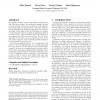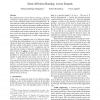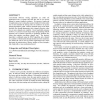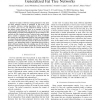107
click to vote
ASPLOS
2010
ACM
15 years 3 months ago
2010
ACM
We present an all-optical approach to constructing data networks on chip that combines the following key features: (1) Wavelengthbased routing, where the route followed by a packe...
ESA
1998
Springer
15 years 4 months ago
1998
Springer
We give two, new upper bounds for oblivious permutation routing on the mesh networks: Let N be the total number of processors in each mesh. One is an O(N0.75 ) algorithm on the tw...
SPAA
2003
ACM
15 years 5 months ago
2003
ACM
We consider an online version of the oblivious routing problem. Oblivious routing is the problem of picking a routing between each pair of nodes (or a set of ows), without knowled...
SPAA
2005
ACM
15 years 6 months ago
2005
ACM
We study oblivious routing in which the packet paths are constructed independently of each other. We give a simple oblivious routing algorithm for geometric networks in which the ...
119
click to vote
SPAA
2006
ACM
15 years 6 months ago
2006
ACM
We initiate the study of semi-oblivious routing, a relaxation of oblivious routing which is first introduced by R¨acke and led to many subsequent improvements and applications. ...
110
click to vote
ESA
2009
Springer
15 years 7 months ago
2009
Springer
Consider the robust network design problem of finding a minimum cost network with enough capacity to route all traffic demand matrices in a given polytope. We investigate the impa...
111
click to vote
ISCA
2009
IEEE
15 years 7 months ago
2009
IEEE
Conventional oblivious routing algorithms are either not application-aware or assume that each flow has its own private channel to ensure deadlock avoidance. We present a framewo...
108
Voted
NOCS
2009
IEEE
15 years 7 months ago
2009
IEEE
Most virtual channel routers have multiple virtual channels to mitigate the effects of head-of-line blocking. When there are more flows than virtual channels at a link, packets o...
95
Voted
CLUSTER
2009
IEEE
15 years 7 months ago
2009
IEEE
—A family of oblivious routing schemes for Fat Trees and their slimmed versions is presented in this work. First, two popular oblivious routing algorithms, which we refer to as S...
STOC
2005
ACM
16 years 21 days ago
2005
ACM





